The Rise & Fall of
WJJY-TV
Channel 14
Jacksonville, Springfield & Quincy, Illinois
ABC television network
© 1996 - 2024, J. Mitch Hopper
www.brainmist.com
Updated October 2024








CLICK ON ANY IMAGE YOU SEE.
|
The Rise & Fall of Updated October 2024 |
 

 


|
CLICK ON ANY IMAGE YOU SEE. |
As the 60s progressed, the television viewing population grew quickly. They demanded more programming material and more viewing choices. Additionally, the RCA corporation, manufacturers of the premier line of television transmission equipment, introduced a new line of transmitters and antennas for the UHF broadcasting market; units capable of previously unreachable power levels. Enter Keith Moyer and the cream of the Jacksonville investing community. Keith had developed WTIM-AM in Taylorville in 1951 and was majority owner of KBBM in Hayward, California. His vision of a powerhouse television station in Jacksonville convinced the investors to create Look Television Corporation and make it a reality. WJJY-TV, channel 14, ABC, Jacksonville, Springfield and Quincy, Illinois was born.
|
Jacksonville Journal, 8-18/19,1969, editorial welcoming the new station. Click to enlarge! |

|
In an effort to capitalize on the largest viewing audience possible, Look Television did three things.
First, they convinced the ABC television network to take on the station as a full-time affiliate and abandon their affiliation with KHQA-TV. WJJY-TV would agree to broadcast everything in the ABC lineup at the time the programs were fed from the network traffic center in the Chicago complex at WLS-TV. No network programs could be delayed or deleted and that contract would run for five years. It can be assumed that it represented a loss of a certain amount of revenue for KHQA-TV.
Second, WJJY-TV would operate at a very high power level. In the late 1960s, typical UHF transmitter power was between 500,000 and 1.5 million watts. The new station would transmit 4.5 million watts. Third, UHF transmissions are "line-of-sight" which means the signal can not go past the horizon. To gain as much viewing territory as possible, the station would locate its transmitter site on the bluffs of the Illinois river utilizing some of the highest ground in the Illinois' west central area. Additionally, it would be transmitted from an antenna located atop a 1,610 foot tower; an unusually tall structure. When WJJY-TV signed on, it held two records; the tower was one of the three tallest structures in the northern hemisphere, and the transmitter radiated the most powerful UHF-TV signal in the world. From that height, the station's horizon was vast and the high power levels meant the signal could penetrate every inch of it.
|
Transmitter with topology and coverage maps.
|



|
To gain such incredibly high power levels, WJJY-TV utilized a unique antenna manufactured by
RCA and only three were ever constructed. Because the station operated on channel 14, the lowest possible
UHF frequency, the physical dimensions of the radiator elements were very large making the antenna the most
massive ever constructed for the commercial UHF market. Two years after WJJY-TV went on the air,
WAND-TV in Decatur, Illinois purchased the second, smaller unit.
The third antenna remained unsold and on the ground at the RCA test facility in Camden, New Jersey.
No one trusted such a large and heavy antenna. Those fears would later be realized.
The complete antenna was so massive that it had to be manufactured and shipped in three separate sections
on three separate trucks. Each part was lifted to the top of the tower individually and stacked by the tower riggers.
The average antenna weight for a UHF transmitting antenna at that time was between two and nine tons.
The RCA "Vee-Zee" panel antenna weighed in at twenty-six tons, not counting the transmission line, radome covers
and mounting plates. The tower itself was constructed with more massive components than usual.
NEW FEATURE: Watch a short video clip of one of the three antenna sections being off-loaded from the flatbed truck.
|
One of the three sections of the antenna being rigged to raise.
|





 



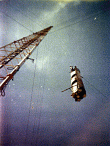
 Color slides courtesy of Harold Eskew, Chief Engineer, WJJY-TV. |
Tower construction, then and now, is a dangerous business. Two of the construction riggers were killed in Texas six months later when an antenna they were hoisting became entangled in the guy wires causing the tower to collapse - with them on it. They were a rough breed; hard drinking, hard talking, and especially hard working. On more than one occasion I watched as they climbed the steel ladder mounted on the inside of the tower, covering the 1,600 foot climb in less than forty-five minutes and taking only two breather-breaks.
|
General tower construction views. Note the last one of the riggers elevator!
|
 < <
 < <





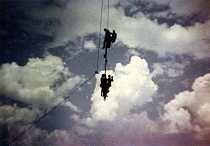
|
Shortly after the antenna was mounted on top of the massive tower and shortly before the station was to officially sign on, transmitter testing began. The station was poised to make a splash entrance on the scene. Full page newspaper ads were placed, an open house was held, and newspaper interviews were given. Then the day before sign on, catastrophy struck. Few riggers and tower construction personnel had any practical experience with the new generation of RCA antennas. Even the RCA field engineers on-site were mystified by the giant behemoth. Unfortunately, the riggers had used standard construction practices and had not allowed for the heavier components of the antenna. One specific component, a connecting 'bullet' in a six-inch transmission line, failed during station testing and arced at full power damaging the upper section of the antenna and delaying the official sign-on by four weeks giving WJJY-TV a very black eye.
|
From the Jacksonville Journal, July 31, 1969 - announcing the sign-on. Left to right; John Mazzotti, Jerry Slade, and Rich Rose. Mike Cheever is behind the camera. Click to enlarge! |
 |
 |
|
Newspaper account and pictures of the damaged 6 inch transmission line and antenna elements.
|
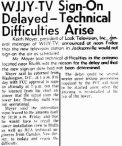

 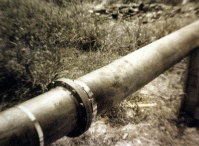
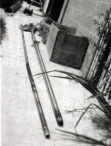 |
The station began normal operations on August 17, 1969, from its studios in Jacksonville. Even though delayed by technical failures and with a potential audience made up of mostly non-UHF households, WJJY-TV hit the air running. From its sign-on time of 9:00 AM to sign-off at midnight, the station kept up a non-stop barrage of self-promotion. The typical day relied heavily on the ABC Television Network, free feature films and travelogues, a 6:00 and 10:00 newscast, The Dick Cavett Show, and an occasional movie. Later, the station picked up the Cardinal Baseball Network, produced by KPLR-TV in St. Louis. It was several weeks before telephone surveys showed that they had any audience at all. However, the enormous power of the transmitter was evident. We began receiving reception reports from as far away as Cape Girardeau and Minneapolis.
|
Video sweep - shows perfect frequency response at full power. ABC program promotion slides and the most frequently used station ID.
|
Click to enlarge! |
Click to enlarge! |
Utilizing standard grade equipment for the time, much of it manufactured by RCA, WJJY-TV broadcast a steady schedule of ABC programming, Cardinals baseball, feature films and items of local interest. The station complex housed live (TK-43) and film cameras (TK-27 w/TP-66 projectors), quadruplex video tape (TR-60A), video control and effects equipment (TS-40A) and an unusually large 8,800 square foot studio for local programming. Redundancy was built into the microwave system to ensure that the ABC network feed, the only serious income in the beginning, would always be available and of high quality.
|
Images of the studio and equipment in various stages of installation. Click to enlarge! |



 



 
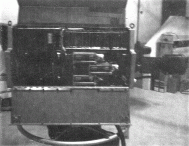
 |
Many of the station personnel utilized WJJY-TV to launch their careers. News anchor, Jerry Slade (changed to Slabe after WJJY), went on to a long association with WCIA-TV in Champaign. Promotions Manager and air personality, Mike Cheever, moved to WAND-TV and was a figure-head in their on-air operations. A young, inexperienced engineer - the second employee put on the Look Television payroll - was hired to assist the Chief Engineer, Harold Eskew, install the broadcast equipment in the studio. That young man has aged some and has gone on to a long career as Chief Engineer for the Illinois State Board of Education, WVEM-FM and Asst. Chief Engineer at WBHW/WZXO/WRSP-TV and is owner/operator of Custom Video Systems Company. That would be myself. It has been a wonderfully strange trip.
Sadly, the investor’s vision was too short-sighted. It was folly to expect the station - any station for that matter - to begin to turn a profit right away. Look Television began to run out of money almost as soon as it had signed on the air. A long year of bounced paychecks, non-payment to vendors and unpaid power bills began to pull the station down. The transmitter site was a voracious consumer of electricity and the utility bills were beginning to mount. More than once, the Chief Engineer, Harold Eskew traveled to the transmitter when it failed and remote control was ineffectual, only to find that WIPCO (Western Illinois Power Cooperative) had cut the power for non-payment. What got the power re-instated was not any financial agreement, but the understanding that the power company was responsible for an un-lighted 1,600 foot airplane hazard.
As an interesting side-note, WJJY-TV entered into the educational television world for a short time. In an effort to attract some state money and to fill a morning air schedule with free material, WJJY-TV aired instructional programming that originated from the Springfield studios of the Illinois Office of the Superintendent of Public Instruction, OSPI (which later became the Illinois State Board of Education). At that time, I had already severed my obligations with the station over non-payment of salary and had taken an engineering position with OSPI. We were actively programming WILL-TV in Champaign/Urbana with a 6:00 a.m. to 2:30 p.m. instructional programming air schedule - a last remnant of the MPATI airborn television project of the early 1960s. OSPI jumped at the chance to simultaneously microwave west to pick up the west-central in-school television viewers and move a bit closer to a dream of a state-wide educational television network. WJJY-TV only had to insert local IDs on the half-hour and let us do the rest. I had gone from assisting in the station's construction to its operation - and was now part of the organization that programmed it. Meanwhile, I spent one evening a week back in Jacksonville, assisting the remaining skeleton staff with VTR repairs on a contract basis. Life is sometimes a wheel, isn't it?
|
A few of the only remaining ID and program bumper slides from the WILL-WJJY-OSPI network days. Click to enlarge! |



 



|
The station was not attracting viewers as fast as the promoters had speculated and the ABC network was talking about voiding the contract and returning to KHQA-TV. The board of Directors of Look Television Corp. discharged Keith Moyers in April, 1970 and had taken direct control of the station. Unsubstantiated rumors ran through the staff about legal troubles with the FCC and the ABC network. Morale dipped, and paychecks began to bounce at the bank. The rumors increased and it was speculated that the FCC had begun proceedings to terminate the station license. Finally five months later, the bank beat them to the punch. Finally, after a year and a half, WJJY-TV ran out of money, time and good fortune. Without fanfare, Master Control signed off at the normal time after The Dick Cavette Show on September 15, 1971 - forever. A short and magical history had come to an end. The full story of the legal issues would take another two months to come to light. On November 8, 1971, a report surfaced in the trade magazine "Broadcasting" concerning an alleged bribery incident dating back to March, 1970 between the station manager, Moyer, and the ABC network. The network executives notified the FCC and an investigation was started. The FCC was considering not renewing the WJJY-TV license - the only thing of worth that Look Television Corporation still had. A few days later on November 20, 1971, an article appeared in the local Jacksonville newspaper bearing the bad news that WJJY-TV, as well as 5 other TV stations, had been involved in the alleged bribery of an ABC official and that the FCC was officially involved. Without a license, the station would be a very hard sell indeed. The station went into receivership and RCA reclaimed most of the equipment and sold it on the used market. Interestingly, I met one of the old TR-60A videotape machines years later while doing contract work for WKAB-TV in Selma, Alabama. I recognized some of my modifications and internal markings. It was like meeting an old friend. The FCC reallocated the call letters to Omni Broadcasting in Brainerd, Minnesota, but their vision was not so grand. The television station was designated as a low power repeater of one of the Minneapolis stations. WJJY-TV and WJJY-FM went on the air in the mid 1970s. By 1980, their television venture had failed and gone off the air. What remains today is just their regional FM radio station running a talk format. The Bluffs tower site, now devoid of a transmitter, was left standing. The cost to recover the antenna or to dismantle the tower was prohibitive and a buyer was sought. The only serious possibility was an offering by the Illinois Office of Education (my employer at that time) or a growing consortium of educational broadcasters known as Convocom, to buy the tower and broadcast educational material. Between 1972 and 1978, the original investors maintained the tower and lights and waited for the governmental entities to make up their minds and arrange financing. Finally, as the wheels of government and the corporate world ground away slowly, the FCC complaint docket came before an administrative law judge, Forest L. McClenning, who heard the case. In the end, Keith Moyers and Look Television were exonerated and the license renewal was approved. Now, there was a possibility of selling the station even though it was simply a license with no hardware - except for the massive tower and antenna at Bluffs. |

 Click to enlarge! 
 Click to enlarge! |
Then, on Easter Sunday morning, 1978, WJJY-TV's history ended abruptly and absolutely. In the pre-dawn hours, a late winter storm of unbelievable proportion moved through the area coating everything in a thick layer of ice. At 1,610 feet, the antenna and tower became a nearly solid block of frozen water three feet thick in many places. The incalculable weight of the ice and the unusually heavy antenna were too much for the structure. It appeared that the tower had buckled midway up and the lower part fell mostly intact to the north-east. The remaining upper tower folded up like an accorian and collapsed onto the building. The antenna appears to have broken in two parts on the way down, cutting one of the guy lines. When it hit the ground, it punched a ten-foot hole and bounced out into the adjacent field. One of the antenna feet had snapped off and was laying near the roadway (visible in the 9th photo below). Though it weighed nearly 90 pounds, I retrieved it and placed it atop a small brick pedestal in my garden where it resides to this day.
Living in the house at the edge of the property, the poor homeowner said his house shook and small items vibrated off the walls and tables. He said that it sounded like a freight train was coming through his living room. He related that the sounds seemed to go on forever. Then, abruptly, it was dead still. By the first light he was able to see the vast array of scrap steel filling the adjacent field. He also saw major sections of the tower and huge blocks of ice which had fallen within twenty feet of his bedroom.
|
Images of the destruction. These photos were taken four days after the collapse. It took that long to get the back roads open. Click to enlarge! |
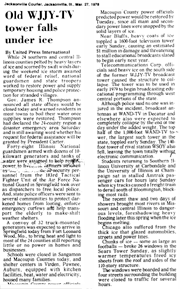 |

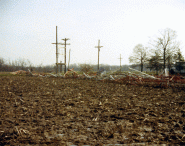

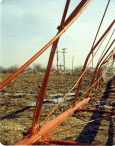 


 

 Click to enlarge! |
Interestingly, WAND-TV, who had purchased a similar antenna mounted on the same kind of tower, erected by the same tower company, suffered the same fate. The top 1,000 feet of their tower fell later that same morning under a similar ice-load. The upper section of their antenna had broken loose and had fallen through the guy wires. Over the next six months, a salvage company removed the 1,610 feet of tower and debris and the nearly five miles of four to six inch guy wire. By the next year the land was returned to farming. The cost to remove the six remaining guy anchor positions and the tower base was prohibitive at the time and they remained. It appears that in the intervening years, some of the guy positions have been removed as no trace seems to remain on Google Earth.
|
More images of the destruction. Click to enlarge! |
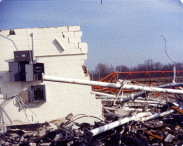







 |
WJJY-TV was one of the more unique chapters in the story of American broadcasting. It was bold and ambitious and provided many individuals with the stepping-stone needed to bridge the gap between training and career. Interestingly, it signaled a change in UHF broadcasting. The new generation of high-power stations was born. Within a short amount of time a great number of UHF stations applied for and were granted variances to their licenses allowing them to increase their power substantially. RCA lost their competitive edge in antenna design and several competing companies designed and constructed simpler and less massive high-power radiators.
After more than fifty years, few people even remember the old station. I still visit the transmitter site every year or so. I see the tower, hear the ghosts and feel the presence of my old friends and comrades. Much concrete and steel still remain after all these years and even though corn now grows where a microwave dish used to be, the toe of my shoe is all that is needed to unearth small nuts, bolts and jagged pieces of metal. Archaeologists from the future centuries will likely not find the historical location of WJJY-TV; they will only find a mystery.
|
The tower site today. Ghosts, steel, and concrete are a playground - and a mystery. Click to enlarge! |

|
 |
 Back
to BRAINMIST.com's Main Menu
Back
to BRAINMIST.com's Main Menu